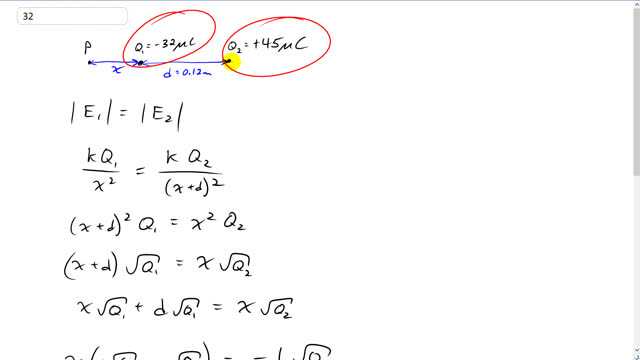
Two point charges, and , are separated by a distance of 12 cm. The electric field at the point P (see Fig. 16–57) is zero. How far from is P?


In order to watch this solution you need to have a subscription.
This is Giancoli Answers with Mr. Dychko. We have a charge of negative 32 coulomb positioned here, we call that Q one and then Q two is a charge of positive 45 micro coulomb, position here 12 centimeters to the right of Q one or 0.12 meters. And there's this point P at distance x to the left Q one which has zero electric field and that means that the electric field due to Q two which will be directed to the left is of equal magnitude to the electric field due to Q one which is directed to the right and the magnitude of electric field due to Q one is k Q one over the distance to P which is x squared. And that's going to equal electric field due to charge two which is k Q two over its distance to P which is the distance separating the charges d plus x squared. And then we'll multiply both sides by x squared to get x squared times Q two on the right. And we're also dividing by, both sides by k. So, the k cancel and we're multiplying both sides by x plus d squared as well. So that cancels on the right side and appears on the left. So we have x plus d squared times Q one equals x squared times Q two and then take the square root of both sides and that gives us x plus d times square root Q one equals x times square root Q two and we'll distribute the square root Q one into the brackets here and we have x times square root Q one plus d times square root Q one equals the right hand side unchanged, x times square root Q two and then collect the x terms together and we'll bring this to the left which makes it a minus x times square root Q two, we'll bring this term to the right which makes it a negative, d square root Q one and then we'll factor the x out from this term and this term and that makes x times bracket square root Q one minus square root Q two and multiply both sides by negative one just to get reduce the number of negative sides we have here and that gives us positive d times square root Q one and on the left side we're switching the order of the these two around. So, the Q one term becomes minus and the Q two term becomes positive. Then divide both sides by this bracket and we isolate x. So, x is d times square root Q one divided by square root Q two minus square root Q one. So, we plug in some numbers and get our answer. So, we have 0.12 meters separating the charges times square root 32 times ten to the minus six coulombs divided by 45 times ten to the minus six coulombs minus 32 times ten to the minus six coulombs and that gives us 0.65 meters must be the distance from the point P to the charge Q one. There we go.
How do we know that E1 and E2 have the same magnitude? Is that always the case, even though one is closer and one has a stronger charge than the other?
Hi magiemay480, thanks for your question. E1 and E2 having equal magnitude is a special case for this question. The reason for it is that the electric field at point "P" is zero, and the only way for that to be possible is if E1 and E2 are of equal magnitude in opposite directions.
Hope that helps,
Mr. Dychko
Thanks so much, Mr. Dychko! You were a lifesaver in my last course and are continuing to be invaluable in E&M as well! :)
You're welcome! I'm glad the videos are helping!
I thought that when dealing with electric fields, the forces always point towards the negative charge. I don't understand why it's pointing to the left for Q1.
NVM